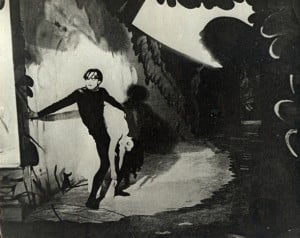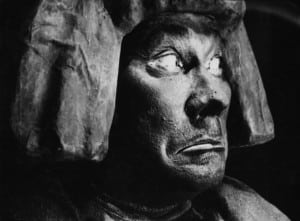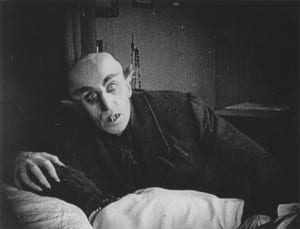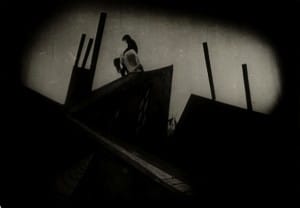Gothic Cinema and the Expressionist Stage
Just like the Old Dark Houses of the Gothic tradition, Gothic cinema is a haunted abode, plagued by the undead spectres of theatre and expressionism. Alex Barrett lights his torch and goes to investigate.
In 1931, Universal Studios kick-started classic horror cinema with the release of Dracula and Frankenstein, two of the most influential and iconic films of all time, derived from two equally important works of literature. Significantly, however, neither film came to the screen direct from the page, but were instead based upon pre-existing stage adaptations of the original texts. Indeed, it had been the success of Dracula on Broadway (and at the Little Theatre in London) which had encouraged Universal to make their film. Though officially credited to Tod Browning, the film is now widely considered to have been co-directed by its cinematographer, Karl Freund – a key figure in both 1930s horror, and what is now commonly referred to as ‘German Expressionism’.

Debates still rage as to what defines ‘Expressionism’, and as to which films can be truly considered ‘Expressionist’, but here it seems sufficient to characterise Expressionist films as works which seek to express their characters’ subjective inner turmoil in an objective outward fashion through the mise-en-scène. The movement (if one can call it such) spread across the arts, infecting not only cinema, but painting, sculpture, literature and – yes – theatre. Among the most important of those working in theatre was director Max Reinhardt, who drew upon Expressionism’s rejection of naturalism in his attempt to create an all-encompassing theatre (he was influenced by the theories of Richard Wagner). Perhaps most importantly, Reinhardt placed special emphasis on décor and pioneered the use of chiaroscuro lighting. He was also responsible for creating the Kammerspiele, a ‘chamber theatre’ for works featuring intimate psychological portraits. A distinction is often made between Kammerspiele and Expressionism (as Expressionists reject psychology and motivation), though the line becomes a little blurred when Kammerspielfilms seek to convey their protagonists’ subjective feelings objectively (and hence the on-going debates).

Whether one accepts the Expressionist tag or not, it’s true that many German films from this period emphasised mise-en-scène and focused on character psychology. What’s also true is that many of the key players from this era worked with Reinhardt before moving into cinema – including, for instance, F. W. Murnau, Ernst Lubitsch, William Dieterle, Emil Jannings, Conrad Veidt, Werner Krauss and Paul Wegener. Wegener, a pioneering actor, writer and director, had begun making Gothic features as early as 1913, with his Edgar Allan Poe-inspired The Student of Prague. In 1915 he teamed up with writer (and former Reinhardt assistant) Henrik Galeen to make The Golem, the first in a trilogy of films Wegener made about the Jewish clay automaton. For the trilogy’s third part, The Golem: How He Came Into the World (1920), Wegener and Galeen teamed up with yet another former Reinhardt collaborator: Karl Freund. (Freund was cameraman on two of Reinhardt’s early flirtations with film: Isle of the Blessed (1913) and A Venetian Night (1914).) Although it’s impossible to say for sure what influence Reinhardt left on Freund and the other German filmmakers of this era, it certainly seems that many of his techniques and theories remain discernible in their work.
Following in the footsteps of many of his contemporaries and collaborators (including Murnau and Lubitsch), Freund emigrated to the USA in 1929, taking the influence of Reinhardt and expressionism with him – influence he clearly brought to bear on Dracula and his other horror films of the 1930s. So as to not overstate the case for Freund’s contribution, however, it may be worth noting that émigré director Paul Leni had already made The Cat and the Canary for Universal (in 1927), and that the Studio probably saw Leni’s film as one of the works that paved the way for Dracula. Back in Germany, Leni had made the seminal expressionist film Waxworks (1924) – which was written by Galeen. Interestingly, though, Leni himself never worked with Reinhardt, despite starting his career as an avant-garde painter and theatrical set designer in Berlin. The Cat and the Canary, meanwhile, was adapted from a 1922 play of the same name.
Following the success of Dracula, Universal assigned Freund to direct The Mummy (1932) – a film which can be seen as harking back to German Expressionism in several ways. For instance, film historian Paul M. Jensen has noted that the The Mummy’s use of camera movement and pacing reflects the German idea of ‘stimmung’, in which action becomes secondary to the unstated, and images evoke psychological atmosphere. Jensen also has compared the content and construction of the sequence in which Helen Grosvenor answers Imhotep’s call to the moment in Nosferatu: A Symphony of Horror (1922) in which Ellen responds to Orlok (and Nosferatu, let’s not forget, was directed by Murnau and written by Galeen, and starred a third Reinhardt steward, Max Schreck).

Other links between The Mummy and Expressionism emerge too, such as the way the flickering to life of the mummy itself recalls both the awakening of Cesare in The Cabinet of Dr. Caligari (1920) and of the titular creature in the 1920 The Golem. (The impact of these two German films is also felt elsewhere: for instance, the sideshow element of Caligari also seems to have influenced Universal’s 1932 Freund-shot Murders in the Rue Morgue, while Frankenstein owes much to The Golem.) The Mummy’s torchlight search through the museum, meanwhile, seems to recall the chase through the catacombs in the Freund-shot Metropolis (1927) – though Jensen has compared it to a scene in The Last Laugh (1924, also shot by Freund).
Freund’s work in The Last Laugh is likewise felt in his 1935 directorial effort Mad Love, which contains a subjective point of view shot – something pioneered by Freund in both The Last Laugh and 1925’s Variety. Interestingly, Mad Love was also a remake of a German Expressionist film (Robert Wiene’s 1924 The Hands of Orlac) and was written by John L. Balderston, who had worked on the stage adaptations of Dracula and Frankenstein that Universal had drawn from in 1931. Balderston also wrote The Mummy for Freund, and there are elements which recur through both films, as well as through Dracula (such as a strange, foreign interloper who threatens the central relationship). The constancy of these ideas seems to suggest that Balderston, like Freund, should be considered a major player in the Classic Horror cycle of the 1930s.
It’s perhaps worth noting that Mad Love was not a Universal production (it was made by MGM), and that Universal were not alone in taking influence from the stage (see, for instance, Paramount’s 1931 Dr. Jekyll and Mr. Hyde, which follows Thomas Russell Sullivan’s stage adaptation). The practice was also not limited to the 1930s: for instance, Henry James’ classic Gothic text The Turn of the Screw came to the screen via the stage – as The Innocents – in 1961. The influence of expressionism, too, is detectable beyond the 1930s, notably in the work of Tim Burton, whose skewed, angular set design seems to owe much to the legacy of silent German cinema (Burton, of course, also paid explicit homage to Frankenstein in both Sleepy Hollow (1999) and his two Frankenweenies (1984 and 2012)). It seems only fair to say, then, that Gothic cinema owes much to both the theatre and expressionism, and to the legacy of Reinhardt, Freund and Balderston.

F.W. Murnau’s Nosferatu is also available throug EUREKA, MASTERS OF CINEMA: SPECIAL BLU-RAY, DVD AND DUAL FORMAT STEELBOOK EDITIONS.




